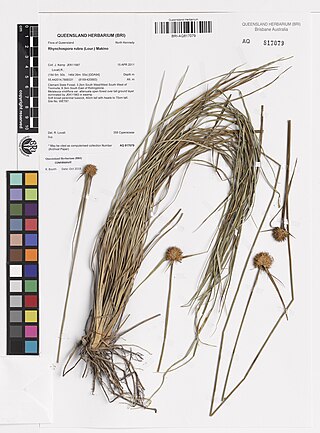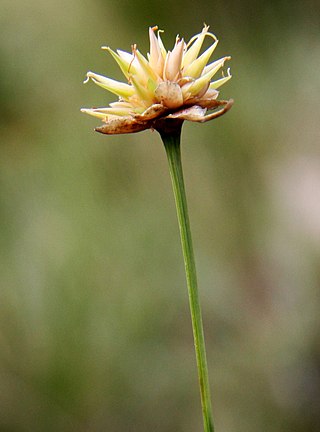
The summer tanager is a medium-sized American songbird. Formerly placed in the tanager family (Thraupidae), it and other members of its genus are now classified in the cardinal family (Cardinalidae). The species's plumage and vocalizations are similar to other members of the cardinal family.

Ulmus rubra, the slippery elm, is a species of elm native to eastern North America. Other common names include red elm, gray elm, soft elm, moose elm, and Indian elm.

Rhynchospora is a genus of about 400 species of sedges with a cosmopolitan distribution. The genus includes both annual and perennial species, mostly with erect 3-sided stems and 3-ranked leaves. The achenes bear a beak-like tubercule and are sometimes subtended by bristles. Many of the species are similar in vegetative appearance, and mature fruits are needed to make a positive identification.

Festuca rubra is a species of grass known by the common name red fescue, creeping red fescue or the rush-leaf fescue. It is widespread across much of the Northern Hemisphere and can tolerate many habitats and climates. It is best adapted to well-drained soils in cool, temperate climates; it prefers shadier areas and is often planted for its shade tolerance. Wild animals browse it, but it has not been important for domestic forage due to low productivity and palatability. It is also an ornamental plant for gardens.

Plumeria rubra is a deciduous plant species belonging to the genus Plumeria. Originally native to Mexico, Central America, Colombia and Venezuela, it has been widely cultivated in subtropical and tropical climates worldwide and is a popular garden and park plant, as well as being used in temples and cemeteries. It grows as a spreading tree to 7–8 m (23–26 ft) high and wide, and is flushed with fragrant flowers of shades of pink, white and yellow over the summer and autumn.

Rhynchospora alba, the white beak-sedge, is a plant in the sedge family, Cyperaceae. It is a tufted herbaceous perennial around 50 cm tall, with white inflorescences that flower in August. The fruit of the sedge is a small achene with a characteristic beak-like cap. It is dispersed by wind or falls by gravity, leading to individuals existing in tight clumps. The species favours wet, acidic and nutrient poor soils, thriving in Sphagnum-dominated bogs, but also peaty grasslands. As such it is often used as a positive indicator for bog and mire ecosystem health.

Echinochloa crus-pavonis is a species of grass known by the common name gulf cockspur grass. It is native to much of the Americas, Africa, and part of Asia, and it is known throughout the world as an introduced species. It is an annual grass often exceeding 1.5 meters in maximum height. The inflorescence is divided into several branches coated in green spikelets.

Digitaria insularis is a species of grass commonly known as sourgrass. It is native to Central and South America and the southern parts of the United States and has been introduced into other parts of the world. It was first described by the German botanist Friedrich Karl Georg Fedde in 1904.
Rhynchospora megaplumosa, the Manatee beaksedge, is a plant species endemic to a small region in central Florida. It is known from only 4 Counties: Polk, Hillsboro, Manatee and Sarasota. It generally grows on sandy soil in pine woodlands.

Brachiaria mutica is a species of grass known by the common names para grass, buffalo grass, Mauritius signal grass, pasto pare, malojilla, gramalote, parana, Carib grass, and Scotch grass. Despite its common name California grass, it does not occur in California; it is native to northern and central Africa and parts of the Middle East, where it is cultivated for fodder. It was introduced elsewhere and it is now cultivated throughout tropical regions of the world for this purpose.

Abildgaardia ovata is a perennial herb of the genus Abildgaardia and the family Cyperaceae. It is a widespread species that can be found in West, Southern and East Afria, Florida, Mexico, the Caribbean and in some countries of Latin America.

Rhynchospora corymbosa, known by the common names of golden beaksedge and matamat, is a member of the sedge family, Cyperaceae. It is a perennial herb, found globally throughout the tropics. It grows up to 2 meters tall in riverbanks, shallow pools, and swamps.

Rhynchospora rugosa, known by the common name of claybank beaksedge, is a member of the sedge family, Cyperaceae. It is a perennial herb, native to Central and South America.

Rhynchospora rubra is a member of the sedge family, Cyperaceae. It found throughout southeast Asia, Oceania, and western and southern Africa.

Rhynchospora globosa, known by the Spanish common name of estrellita de sabana, is a member of the sedge family, Cyperaceae. It is a perennial herb, found throughout the tropics of Central and South America. The variant R. globosa var. tenuifolia is endemic to Cuba.

Rhynchospora chapmanii, known by the common name of Chapman's beaksedge, is a member of the sedge family, Cyperaceae. It is a perennial herb, found in wetlands of the southeastern United States from North Carolina to Louisiana, as well as in Belize, Cuba, Honduras, and Nicaragua.

Rhynchospora brachychaeta, known by the common name of West Indian beaksedge, is a member of the sedge family, Cyperaceae. It is a perennial herb, found in wetlands of the southeastern United States, the Caribbean, Central America, and Guyana.

Rhynchospora chinensis, known by the common name of spiked beaksedge, is a member of the sedge family, Cyperaceae. It is a perennial herb, found in wetlands of Japan, Korea, eastern China, Mainland Southeast Asia, India, Australia, and Madagascar. It was once present in Sri Lanka, where it is now locally extinct. The subspecies R. chinensis subsp. spiciformis is endemic to Hawaii.

Rhynchospora ciliaris, known by the common name of fringed beaksedge, is a member of the sedge family, Cyperaceae. It is a perennial herb, found in wetlands of the southeastern United States, from New Orleans to Morehead City.
Rhynchospora gracillima is a widespread species of sedge.



















